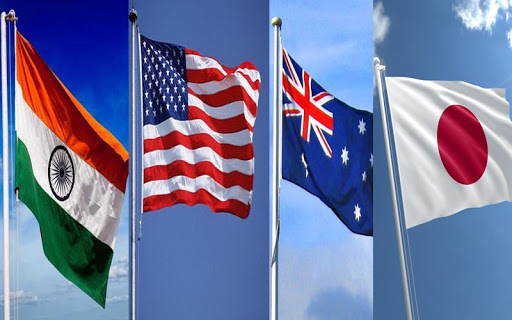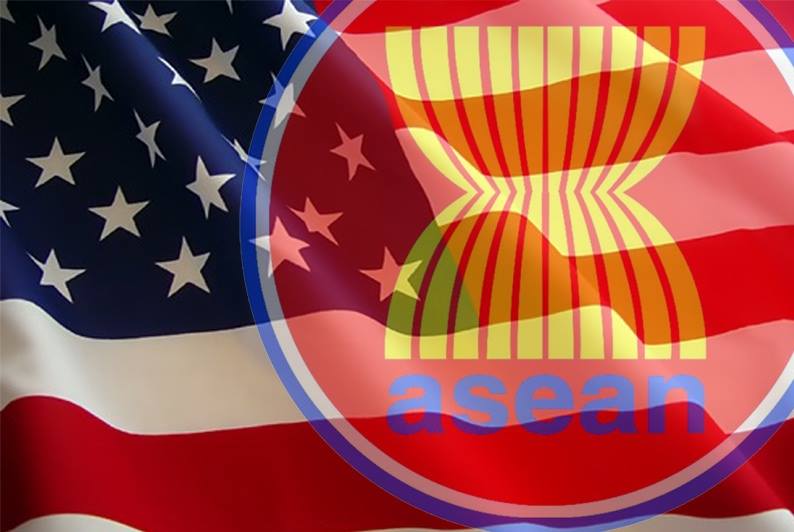BY: Gabriel Joel P. Honrada*

PEJOURNAL – There are two emerging guarantors of the multilateral rules-based order in the Indo-Pacific. First is the Quadrilateral Security Dialogue (Quad) between the US, Australia, Japan, and India. Second is the Association of Southeast Asian States (ASEAN). Both organisations attempt to uphold the rules-based order in the Indo-Pacific, albeit via different means. The Quad provides a tangible enforcing presence and backs up the rules-based order in the Indo-Pacific with the threat of military force.
In comparison, ASEAN takes a softer approach of interaction, socialisation, and integration to preserve the same. In view of China’s excessive claims in the South China Sea, the question stands whether the Quad complements ASEAN with hard instruments of state power, or completely replaces ASEAN as its norms have failed to rein in China’s expansionist ambitions.
The Quad Alliance
The Quad was first conceptualised in 2007 but revived in 2017. Initially considered a stillborn initiative, its revival was spurred by four key factors: intersecting strategic interests between its members, apprehension about China’s rise as a global power, non-traditional security challenges, and a shared vision for the Indo-Pacific region. During the Quad’s first working-level meeting held in Manila on 12 November 2017 the Quad members mentioned the mission areas that they will work on, namely a free and open Indo-Pacific, rules-based order, freedom of navigation and overflight, respect for international law, connectivity, maritime security, nuclear proliferation, terrorism, and future plans.
The most visible advantage of the Quad over China is in its sheer military budget. In 2019, the Quad had a combined military budget of USD 876.6 billion compared to China’s USD 261.1 billion. By and large, the Quad outstrips China in terms of military spending. Another advantage of the Quad is its shared vision a maritime rules-based order with other states, and its apparent support to ASEAN centrality as the foundation of regional order in the Indo-Pacific.
Also, the Quad shares democratic values, ideals, and institutions with most ASEAN states, ostensibly forming an arc of democracy to promote the idea of democratic peace throughout the Indo-Pacific region. In practice, the Quad has been instrumental in realising Exercise Malabar 2020, with all Quad nations participating for the first time in the said naval exercise as a veiled threat against China.
However, the Quad has been criticised for its inability to make a unified stand on Indo-Pacific issues, lack of democracy promotion efforts, lack of actual military operations, and lack of institutionalisation. Overall, the Quad remains a mere dialogue at present, and it is unclear in what direction it will evolve. Further, each member state faces its own challenges.
First, Japan still faces traditional constraints in expanding its military footprint in the Indo-Pacific. Japan is still constrained by Article 9 of its Constitution, which makes the acquisition of offensive military capabilities for Japan politically and socially unpalatable. Further, the US also places some restraints on Japan’s use of military force. The US-Japan Mutual Defence Treaty views Japan’s security environment through a Cold War lens, keeping Japan dependent on the US for its strategic security, limiting Japan from playing a larger role in Indo-Pacific security.
Second, India’s longstanding disputes with Pakistan over Kashmir and China in the Himalayas can divert its time, resources, and attention from maritime concerns in the Indo-Pacific. Further, some Indian policymakers can be critical about playing a larger role the Quad, as India risks becoming another subordinate US ally by investing in the Quad.
Third, Australia may be cautious in participating in the Quad, in view of economic coercion from China. China is Australia’s top export partner, and Chinese import bans of major Australian agricultural exports and restrictions on other sectors, such as education, finance, and tourism can make Australia think twice.
Fourth, as the US is the main proponent of the Quad, it faces difficulties in wooing other states, such as ASEAN to get along its agenda. For some ASEAN members, the Quad is simply a means of the US to preserve its hegemony in the Indo-Pacific against China. That said, the Quad has the potential to dilute ASEAN’s role as the foundation of Indo-Pacific security, ultimately leading to potentially dangerous great power rivalry in the region.
ASEAN
ASEAN has long been described as the foundation of regional security in the Indo-Pacific. The organisation’s norms are central to its role as such. These norms are non-interference, respect for sovereignty, informality, and consensus. With these norms, the organisation’s roles in maintaining security in the Indo-Pacific can be described as those of ‘primary manager’ and ‘regional conductor’.
As a primary manager, ASEAN serves as a framework for its member states with which to conduct their transactions and settle disputes. In this sense, ASEAN keeps its member states in control of regional affairs in Southeast Asia. As a regional conductor, ASEAN tries to harmonise the interests of competing powers in the Indo-Pacific region, by having these powers sit together in various forums and affirm at least in principle to abide by ASEAN’s norms. In terms of maintaining regional security, ASEAN works through preventing conflict using relations between leaders and other non-binding means, protecting shared regional interests through expanding its political and security agenda, and to some extent reassuring its members through humanitarian and peace-building efforts.
Paradoxically, ASEAN’s greatest strength as an institution is its loose institutionalisation. This can be described as the ‘ASEAN Way’ where the organisation relies on patient consensus-building to arrive at informal understandings or loose agreements. By avoiding strong Western-style institutionalisation and not presenting its own agenda in a legalistic, obligatory manner, ASEAN does not frustrate competing powers in the Indo-Pacific, but embeds these powers it its framework and provides them multiple areas of engagement.
As such, ASEAN has brought the US, China, India, Japan, and Australia to engage in various forums, such as ASEAN+3, East Asia Summit, and ASEAN Regional Forum. This “bringing together” of competing Indo-Pacific powers through dialogue provides some degree of assurance and certainty to an otherwise anarchic Indo-Pacific security environment.
However, ASEAN is not without its weaknesses. ASEAN members themselves have different appreciations of Southeast Asia’s strategic environment, as Southeast Asia is divided into maritime and mainland areas. That said, not all ASEAN members are party to the South China Dispute, such as Myanmar, Thailand, Cambodia, and Laos, which makes them generally indifferent to the issue. Also, ASEAN is divided by US-China allegiances.
Countries that are strategically dependent on China such as Laos and Cambodia are likely to support the latter’s position, while Singapore and Philippines are more likely to take a pro-US position. Further, ASEAN’s indecision and reluctance to take a tough stance on regional security issues, such as the South China Sea disputes and Rohingya refugee crisis puts into question its credibility and reliability as an arbiter of regional security in the Indo-Pacific.
The Quad; A Complement or Replacement for ASEAN?
The relationship between the Quad and ASEAN can be viewed as complementary or replacing. In a complementary sense, the both share the view of the Indo-Pacific region as a common maritime space and mental map. Further, many of the Quad’s mission areas in non-traditional security overlap with those of ASEAN. In a replacing sense however, the Quad is evolving to become the new guarantor of Indo-Pacific security, and ASEAN as an organisation would be pushed into irrelevance, taking on a largely trivial role.
The Quad and ASEAN share the Indo-Pacific as a mental map of their shared maritime space, yet there are some nuances in their definitions. ASEAN views the Indo-Pacific as not as contiguous territorial spaces but as a closely integrated and interconnected region, with itself playing a central and strategic role. For the US, the Indo-Pacific spans a vast stretch of the globe from the west coast of the United States to the western shores of India. India’s concept includes the entire Indian Ocean and the Western Pacific.
Japan’s concept includes the African east coast, Indian Ocean, to the Pacific Ocean, with ASEAN as the hinge between the two oceans. Australia thinks of the Indo-Pacific as encompassing the northeast quadrant of the Indian Ocean and the Western Pacific. With these various definitions of what Indo-Pacific is, both ASEAN and the Quad can come up with a shared Indo-Pacific concept that can help frame the region in terms both parties’ shared interests.
Further, many of the Quad’s mission areas parallel those of ASEAN, namely upholding a rules-based international order, freedom of navigation and overflight, respect for international law, maritime connectivity, and maritime security. However, creating or finding the appropriate forum in which to do so remains a challenge. Moreover, ASEAN may be wary of damaging its credibility as a neutral and competent regional conductor by formalising and institutionalising its engagements with the Quad.
One can also argue that the Quad takes up the slack where ASEAN has failed, and effectively replaces ASEAN as a guarantor of regional security, confining the latter to relatively trivial regional affairs. ASEAN’s norms and practices are emblematic of soft power, the ability of a country to persuade others to do what it wants without force or coercion.
However, it can be argued that the utility of strategic partnerships trumps the value of soft power. If the logic of soft power were to be applied to China’s excessive maritime claims and aggressive actions in the South China Sea, it follows that China would lose credibility as an international actor, lose influence in international affairs, or turn into a pariah state. But in fact, the opposite has happened.
Despite China’s excessive maritime claims declared invalid by the Permanent Court of Arbitration (PCA) in 2013, China still remains a Permanent Member of the UN Security Council, the vice president of the International Criminal Court of Justice (ICJ) is Chinese, and many countries have signed deals with China for strategic infrastructure projects under the latter’s Belt and Road Initiative.
Further, ASEAN’s failure to form a united front against China’s expansionism cuts directly against the organisation’s reason for existence as a guarantor of regional security for its members. Individual ASEAN members may be forced to bandwagon, accommodate, hedge, or balance between China or the Quad for security and investment in their strategic industries and sectors, ultimately degrading ASEAN’s integrity and relegating it to a trivial role.
Conclusion
Whether the Quad will complement or replace ASEAN is an open question. But with the recent election of Joe Biden and his pledge to reinvigorate democracies as US President, it is highly likely that the Quad will play a more active role in Indo-Pacific security, ranging from coming up with actual military operations and exercises, providing regional public goods, to promoting democratic governance in the region.
Also, whether the Quad institutionalises into a more formal grouping also remains to be seen. In the case of ASEAN, it may try to accommodate the Quad to address non-traditional security challenges, but even this form of accommodation can be challenging, as the proliferation of grey zone tactics blurs the distinction between traditional and non-traditional security, complicating possible areas for complementation between the Quad and ASEAN.
Ultimately, both the Quad and ASEAN will likely evolve in parallel with each other, playing a complex dynamic of complementation where transaction costs and risks are low, and distancing in issues where one side is reluctant to take action or where costs and risks are high. Individual ASEAN members will also consider their desired level of interaction with the Quad, ASEAN, and China, in view of their national interests, playing a delicate balancing game between the Quad, China, and their level of involvement with ASEAN as an institution.
* Gabriel Honrada is an International Relations Master’s student at the People’s Friendship University of Russia under the Russian government scholarship. His research focuses on Indo-Pacific military affairs and Russia in the Indo-Pacific.
